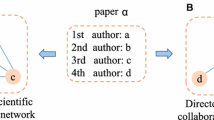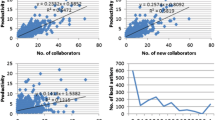Abstract
While implementing a large-scale research project, it is necessary to appoint some principle scientists, and let each principle scientist lead a research group. In a scientific collaboration community, different scientists perform different roles while they implement the project, and some scientists may be more active than others; these active scientists often undertake the role of leadership or key coordinator in the project. Obviously, we should assign the role of principle scientists onto those active actors in the communities. In this paper, we present the model and algorithms for locating active actors in the community based on the analyses of scientists’ interaction topology, the actors with high connection degrees in the interaction topology can be considered as active ones. Finally, we make some case studies for our model and algorithms.
Similar content being viewed by others
References
Leclerc, M., Gagné, J., International scientific cooperation: The continentalization of science, Scientometrics, 31(3) (1994): 261–292.
Melin, G., Persson, O., Studying research collaboration using co-authorships, Scientometrics, 36 (1996): 363–377
Kretschmer, H., Cooperation structure, group size and productivity in research groups, Scientometrics, 7(1–2) (1985): 39–53.
Newman, M. E. J., The structure of scientific collaboration networks, PNAS, 98(2) (2001): 404–409.
Newman, M. E. J., Coauthorship networks and patterns of scientific collaboration, PNAS, (101) (1) (2004): 5200–5205.
Profile of 973 Program. http://www.973.gov.cn/English/Index.aspx
Girvan, M., Newman, M. E. J., Community structure in social and biological networks, Proc. Natl. Acad. Sci, 99 (2002): 8271–8276.
Wagner, C. S., L. Leydesdorff, Mapping the network of global science: comparing international co-authorships from 1990 to 2000. International Journal of Technology and Globalisation, 1(2) (2005): 185–208
Jiang, Y. C., Xia, Z. Y., Zhang, S. Y., An adaptive adjusting mechanism for agents distributed blackboard architecture, Microprocessors and Microsystems, (Elsevier Science), 29(1) (2005): 9–20.
Freeman, L., A set of measures of centrality based upon betweenness. Sociometry, 40 (1977): 35–41.
Granovetter, M. S., The strength of weak ties, The American Journal of Sociology, 78(6) (May, 1973): 1360–1380.
Burt, R. S., Structural Holes:The Social Structure of Competition. Cambridge, Massachusetts, Harvard University Press, 1992.
Author information
Authors and Affiliations
Corresponding author
Rights and permissions
About this article
Cite this article
Jiang, Y. Locating active actors in the scientific collaboration communities based on interaction topology analyses. Scientometrics 74, 471–482 (2008). https://doi.org/10.1007/s11192-007-1587-1
Received:
Published:
Issue Date:
DOI: https://doi.org/10.1007/s11192-007-1587-1




